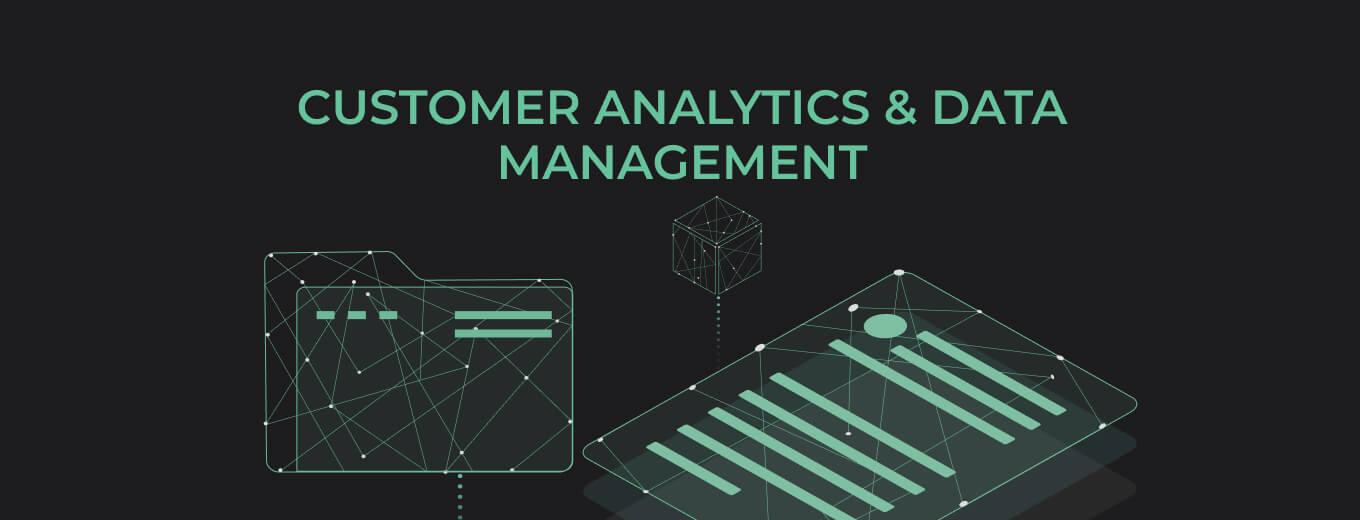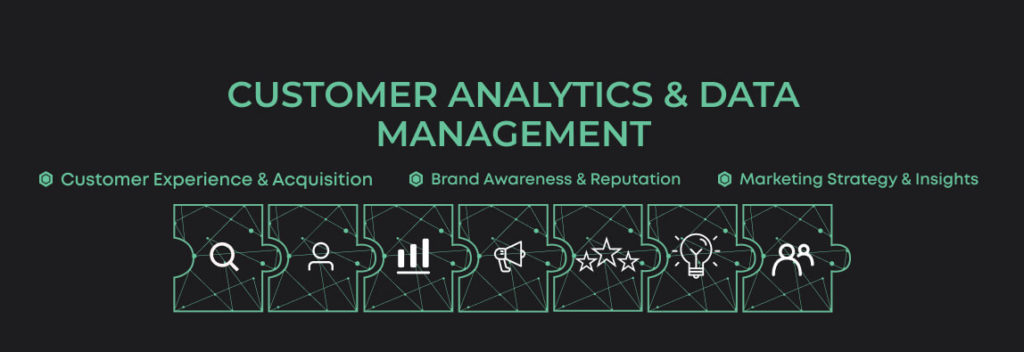
Svitlana Rakova
СОО



Data is the most valuable asset for modern business. Whoever owns information and uses it properly can achieve greater success and profits. Organizations of all sizes must learn how to use data to their advantage to add value to their business, and they need to focus on buyer’s centricity first. By adopting a customer data management strategy, you can better understand your customer base and tailor your approach to each client. That way, you can increase loyalty, increase profits, and more. In this article, we’ll look at the importance of client data management, its benefits, and the top management strategies & how to use them correctly.
Customer analytics is an in-depth, systematic study of customer data. With it, companies can identify multiple client segments and then work with each of them individually, which improves the customer experience and positively affects the company’s performance. For example, you can find clients who are more loyal to your services and those who are considering switching providers. With the help of client analytics, you can identify, attract and retain the most profitable clients.
Purchasers can always find something better for themselves in today’s competitive world. The size of the market allows for this. At the same time, companies need to offer clients something that might interest them. Companies use client analytics tools to understand what’s best to offer their audience. Organizations that better understand their customers’ lifestyles and buying habits will be able to predict their behavior based on accurate data, not intuitive levels, as was the case just a few years ago. Customer analytics is becoming more and more accurate, giving companies a great chance to attract and retain as many purchasers as possible.
Customer data management is the tool and strategy used for customer analytics. This process includes storing, organizing, collecting, and analyzing client data.
CDMs translate the collected data into meaningful customer profiles that the marketing and sales team can use to their advantage while developing a customer data management strategy. It also allows you to segment your customers to understand better who can be offered what service with a high probability of them accepting it.
However, the responsibilities of this process do not end there, as CDM also works with legal and IT departments to ensure that the chosen analytics solution and strategy do not conflict with laws and that the technology used is fair.
Client analytics is an important part of any business that allows your company to succeed and improve customer experience. Below, we will break down the top benefits of client data analytics.
In today’s business, the most win-win option for marketing is data-driven marketing. By basing your marketing strategy on data, you can expect more accurate and faster results. By analyzing customer data, you’ll be able to take everything into account down to the smallest detail. It becomes possible as not only survey results or buyer feedback will be taken into account, but also the frequency of certain pages views, time, etc. In collecting qualitative and quantitative data, your marketing team will be able to understand what to emphasize in your strategy, what processes need to be cut, and what your problem areas are.
To gather this or that information, it’s important to use multiple data sources. These can be your standard web analytics and targeted advertising platforms.
Some may not have known it, but it costs a business a lot more to acquire new customers than to retain existing ones. Maintaining client analytics means you can better understand your customers and offer them something they can’t refuse. As a result, client satisfaction levels will be top-notch. And who’s going to want to leave a good place?
The main beauty of data analysis is its comprehensive help. If a company understands customers’ needs, what motivates them, and what prevents them from making purchases, it can significantly increase its sales. After all, solving an issue is easy if you know exactly what the cause is. For example, you can visually observe all the metrics by breaking down client analytics into several segments (depending on your goal). If any segment’s performance is low, you can easily figure out what to fix. But, on the other hand, customers stay happy because they enjoy using your services.
Client analytics solves many problems, including cost savings in customer acquisition, by giving organizations additional insights into potential customers, such as demographics, age, gender prevalence, interests, etc. This way, any customer acquisition campaign you run will be much more effective because you’ll know exactly where to “hit.”
With client data management, you’ll be able to prioritize the right updates to your products and decide which features are worth including in your services first. For example, tracking feature usage rates will show you what your customers are most interested in. It’s also very important to get customer feedback on the issues you’re interested in through surveys, interviews, etc. Monitoring user reactions to potential features will help you find gaps before launching them, allowing you to make sure that your work will be in demand.
Client analytics allows you to identify the touchpoints between the company’s capabilities and the customer’s desire to provide a more personalized customer experience. Of course, customer experience personalization is difficult to implement without accurate data to drive conversion and engagement. But when companies incorporate client analytics into their processes, they can see increases in metrics like overall customer satisfaction and customer loyalty.

Once you’ve seen that implementing client data management will be good for your business, you probably have a question about how to do data analysis. We’ve highlighted a 5-step guide on how to do data analysis below effectively.
Companies have no problem with where to get their data from, as they are receiving new information every second; the only problem is how to apply it. To do effective data analysis, you must first know your goals. What problem do you want to solve with this or that data? This will help you understand what type of analysis you will do next. For example, you want to know why many customers are dissatisfied with customer service.
You need to figure out exactly what ratios to use to find the root of the problem. For example, if you want to know the productivity level of your support team, you can examine the average amount of time it takes each employee to respond to a purchaser. Then measure each employee’s performance separately against the average.
Data collection includes these types of data:
Quantitative data is often stored in Excel spreadsheets, and qualitative data can be found in the same social networks, Jimmail, and other tools and platforms that you use daily.
To process data efficiently, you can use special tools for data analysis, which is now enough. You can use them to visualize the collected data with charts, graphs, etc. There are also more in-depth methods of data analysis, which we will discuss later.
You can conclude from the results in the form of data analysis reports. Data analysis reports are a very useful practice. A set of diverse information will not be useful to you unless it is formulated properly. Make sure you put all the essentials and speak strictly to the point. You can find a free example of a data analysis report on any website; it will help you understand how to do the data work for you and not just state the facts, but also allow you to find a way to solve problems.
After that, you’ll be able to confidently start making decisions that will help you solve the original problem.
We mentioned deep client analytics methods above, and now we’ll talk more about them. When dealing with data management and customers, companies should be aware of the four main categories of client analytics:
Speaking of the types of client analytics, the following can be highlighted:
This data helps a company understand customers’ feelings when interacting with the brand. The data for this analytics can be obtained from the customer service department, considering satisfaction scores, response times, and customer feedback.
You need to know everything, purchase history, product usage, or purchaser cart abandonment, to improve the customer experience. To do this, study social media comments and traffic to the product page. Also, study the indicators of cart abandonment.
This type of analytics allows you to respond to customer needs promptly and increase sales simultaneously. This requires the company to examine qualitative and quantitative data from various channels, such as customer reviews and e-marketing metrics.
You can make your services more personalized with loyalty analytics, keeping customers near you for years to come. To use this type of loyalty successfully, study online reviews of your services online, and take quality surveys.
Retention analytics allows you to see the factors of customer attraction and churn. Then, you can use it to predict future trends based on historical data and prevent customer churn.
Every business needs to know its best customer. Once you have identified that segment, you must develop a strategy to retain it. You must also know the expected benefits of those customers. By identifying the CLTV for each customer, you can optimize your marketing and sales process.
Thus, client analytics is a large set of different approaches and methods that allow you to understand your customer better. Nevertheless, the effect of this process will always be the same – greater customer satisfaction, higher sales, and lower costs.
Comments